#Francis Edward Faragoh
Explore tagged Tumblr posts
Text











Frankenstein, 1931
#drama#horror#sci-fi#frankenstein#james whale#mary shelley#peggy webling#john l. balderston#garrett fort#francis edward faragoh#richard schayer#robert florey#john russell#boris karloff#marilyn harris#halloween#phrenology being proved wrong love it
12 notes
·
View notes
Text
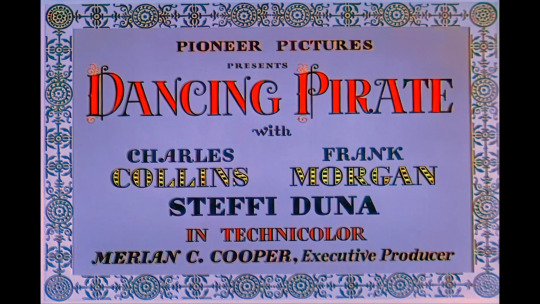

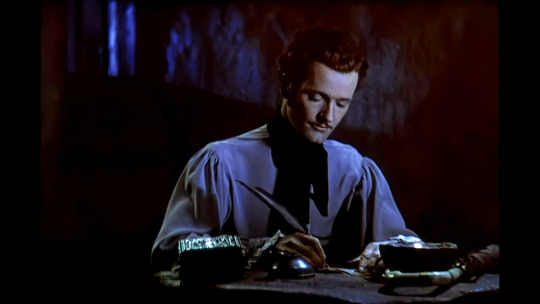
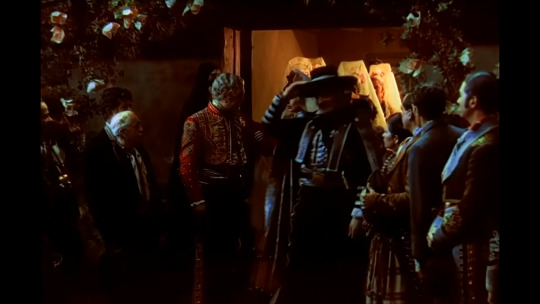
youtube
Dancing Pirate (1936)
My rating: 4/10
The plot is fluffy nonsense, which would be completely fine if the song and dance stuff were any good - unfortunately, it is not really; it seems like they genuinely just had Collins improvise a lot of it, so it looks rather haphazard and disjointed.
#Dancing Pirate#Lloyd Corrigan#Ray Harris#Francis Edward Faragoh#Jack Wagner#Charles Collins#Frank Morgan#Steffi Duna#Youtube
1 note
·
View note
Text

The Universal Classic Monsters Collection will be released on 4K Ultra HD (with Digital) in digibook packaging on October 3 via Universal. Designed by Tristan Eaton, the eight-disc set is limited to 5,500.
It includes 1931's Dracula, 1931’s Frankenstein, 1932’s The Mummy, 1933’s The Invisible Man, 1935’s The Bride of Frankenstein, 1941’s The Wolf Man, 1943’s Phantom of the Opera, and 1954’s Creature from the Black Lagoon.
All eight films are presented in 4K with HDR10. The Spanish version of Dracula is also included. Special features are listed below, where you can also see more of the packaging.
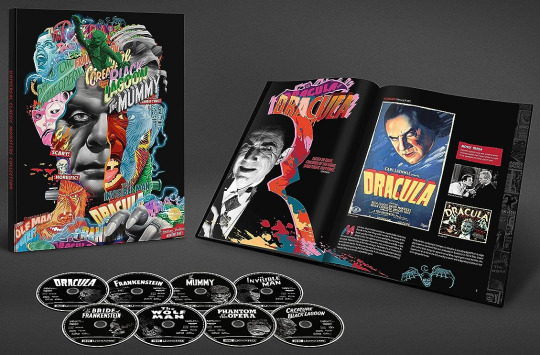
Dracula is directed by Tod Browning (Freaks) and written by Garrett Fort (Frankenstein), based on Bram Stoker’s 1897 novel. Bela Lugosi, David Manners, Helen Chandler, Dwight Frye, and Edward Van Sloan star.
Dracula special features:
Alternate score version by Philip Glass
Dracula (1931) Spanish version directed by George Melford
The Road to Dracula
Lugosi: The Dark Prince
Dracula: The Restoration
Dracula Archives
Monster Tracks
Trailer gallery
Transylvanian vampire Count Dracula bends a naive real estate agent to his will, then takes up residence at a London estate where he sleeps in his coffin by day and searches for potential victims by night.
Frankenstein is directed by James Whale (The Indivisible Man) and written by Garrett Fort (Dracula) and Francis Edward Faragoh (Little Caesar), based on Mary Shelley’s 1818 novel. Colin Clive, Mae Clarke, John Boles, and Boris Karloff star.
Frankenstein special features:
Audio commentary by film historian Rudy Behlmer
Audio commentary by historian Sir Christopher Frayling
The Frankenstein Files: How Hollywood Made A Monster
Karloff: The Gentle Monster
Universal Horror
Frankenstein Archives
Boo!: A Short Film
100 Years of Universal: Restoring the Classics
Monster Tracks
Trailer gallery
Dr. Frankenstein dares to tamper with life and death by creating a human monster out of lifeless body parts.
The Mummy is directed by Karl Freund (Dracula) and written by John L. Balderston (Dracula). Boris Karloff, Zita Johann, David Manners, Edward Van Sloan, and Arthur Byron star.
The Mummy special features:
Audio commentary by film historian Paul M. Jensen
Audio commentary by Rick Baker, Scott Essman, Steve Haberman, Bob Burns, and Brent Armstrong
Mummy Dearest: A Horror Tradition Unearthed
He Who Made Monsters: The Life and Art of Jack Pierce
Unraveling the Legacy of The Mummy
The Mummy Archives
100 Years of Universal: The Carl Laemmle Era
Trailer gallery
An Egyptian mummy searches Cairo for the girl he believes is his long-lost princess.
The Invisible Man is directed by James Whale (Frankenstein) and written by R.C. Sherriff (Goodbye, Mr. Chips), based on H.G. Wells’ 1897 novel. Gloria Stuart, Claude Rains, William Harrigan, Dudley Digges, and Una O'Connor star.
The Invisible Man special features:
Audio commentary by film historian Rudy Behlmer
Now You See Him: The Invisible Man Revealed
Production Photographs
100 Years of Universal: Unforgettable Characters
Trailer gallery
A scientist finds a way of becoming invisible, but in doing so, he becomes murderously insane.
The Bride of Frankenstein is directed by James Whale (Frankenstein) and written by William Hurlbut. Boris Karloff, Colin Clive, Valerie Hobson, and Elsa Lanchester star.
The Bride of Frankenstein special features:
Audio commentary by film historian Scott MacQueen
She’s Alive! Creating The Bride of Frankenstein
The Bride Of Frankenstein Archive
100 Years of Universal: Restoring the Classics
Trailer gallery
Dr. Frankenstein, goaded by an even madder scientist, builds his monster a mate.
The Wolf Man is directed by George Waggner (Operation Pacific) and written by Curt Siodmak (I Walked with a Zombie). Claude Rains, Warren William, Ralph Bellamy, Patric Knowles, Bela Lugosi, and Lon Chaney Jr. star.
The Wolf Man special features:
Audio commentary by film historian Tom Weaver
Monster by Moonlight
The Wolf Man: From Ancient Curse to Modern Myth
Pure in Heart: The Life and Legacy of Lon Chaney Jr.
He Who Made Monsters: The Life and Art of Jack Pierce
The Wolf Man Archives
100 Years of Universal: The Lot
Trailer gallery
Larry Talbot returns to his father's castle in Wales and meets a beautiful woman. One fateful night, Talbot escorts her to a local carnival where they meet a mysterious gypsy fortune teller.
Phantom of the Opera is directed by Arthur Lubin and written by Eric Taylor (The Ghost of Frankenstein) and Samuel Hoffenstein (Dr. Jekyll and Mr. Hyde). Claude Rains, Nelson Eddy, Susanna Foster, and Edgar Barrier star.
Phantom of the Opera special features:
Audio commentary by film historian Scott MacQueen
The Opera Ghost: A Phantom Unmasked
Production Photographs
100 Years of Universal: The Lot
Theatrical trailer
An acid-scarred composer rises from the Paris sewers to boost his favorite opera understudy’s career.
Creature from the Black Lagoon is directed by Jack Arnold (The Incredible Shrinking Man) and written by Harry Essex and Arthur A. Ross. Richard Carlson, Julia Adams, Richard Denning, Antonio Moreno, Nestor Paiva, and Whit Bissell star.
Creature from the Black Lagoon special features:
Audio commentary by film historian Tom Weaver
Back to the Black Lagoon
Production Photographs
100 Years of Universal: The Lot
Trailer gallery
A group of scientists try to capture a prehistoric creature luring in the depths of the Amazonian jungle and bring it back to civilization for study.
Pre-order Universal Classic Monsters Collection.
#universal monsters#dracula#frankenstein#the mummy#creature from the black lagoon#the wolf man#bride of frankenstein#phantom of the opera#the invisible man#horror#classic horror#dvd#gift#the bride of frankenstein#tristan eaton#wolf man
102 notes
·
View notes
Text
Dread by the Decade: Frankenstein
👻 You can support me on Ko-fi ❤️

★★★★★
Plot: An aristocratic scientist grows unhinged as he embarks on a dark quest to create life.
Review: An emotionally turbulent tragedy with memorable characters and iconic visuals that permanently changed cinema.

Source Material: Frankenstein; or, The Modern Prometheus by Mary Shelley Year: 1931 Genre: Sci-fi Horror, Gothic Country: United States Language: English Runtime: 1 hour 10 minutes

Director: James Whale Writers: Garrett Fort, Francis Edward Faragoh, Robert Florey, John Russell Cinematographer: Arthur Edeson Cast: Colin Clive, Mae Clarke, John Boles, Boris Karloff, Edward Van Sloan, Frederick Kerr

-----
Story: 4/5 - Though it departs from its source material, it’s still an engaging exploration of the dangers of obsession and violence born from neglect.
Performances: 5/5 - Clive gives a career best performance as a man consumed by his pursuits, and Karloff invokes both fear and pity without a word.
Cinematography: 4.5/5 - Great use of shadow and camera angles.

Editing: 4/5
Effects: 4.5/5 - Solid props, lightning effects, and pyrotechnics.
Sets: 5/5 - Elaborate, diverse sets and locations. The lab is iconic.
Costumes, Hair, & Make-Up: 5/5 - Great costumes. The Monster's makeup is corpse-like and uncanny without taking away from his often child-like expressions.
youtube
Trigger Warnings:
Mild ableism
Mild violence
Child murder
Abuse
#Frankenstein (1931)#Frankenstein#James Whale#science fiction#sci-fi horror#gothic#Dread by the Decade#review#1930s#★★★★★
15 notes
·
View notes
Photo
Frankenstein (James Whale, 1931)
Cast: Colin Clive, Mae Clarke, John Boles, Boris Karloff, Frederick Kerr, Dwight Frye, Edward Van Sloan, Lionel Belmore, Marilyn Harris. Screenplay: Garrett Fort, Francis Edward Faragoh, based on a story treatment by John L. Balderston of a play by Peggy Webling adapted from a novel by Mary Shelley. Cinematography: Arthur Edeson. Art direction: Charles D. Hall. Film editing: Clarence Kolster. Music: Bernhard Kaun.





Elizabeth’s wedding dress in Frankenstein (1931) Costume design by Vera West
3K notes
·
View notes
Text
FRANKENSTEIN (1931) needs no introduction but must watch. (1102)

Frankenstein is a 1931 American pre-Code science fiction horror film directed by James Whale, produced by Carl Laemmle Jr., and adapted from a 1927 play by Peggy Webling, which in turn was based on Mary Shelley's 1818 novel Frankenstein; or, The Modern Prometheus. The Webling play was adapted by John L. Balderston and the screenplay written by Francis Edward Faragoh and Garrett Fort, with uncredited contributions from Robert Florey and John Russell. Wikipedia

Frankenstein stars Colin Clive as Henry Frankenstein (Victor Frankenstein in the novel), an obsessed scientist who digs up corpses with his assistant in order to assemble a living being from body parts. The resulting creature, often known as Frankenstein's monster, is portrayed by Boris Karloff.

In 1991, the United States Library of Congress selected Frankenstein for preservation in the National Film Registry as being "culturally, historically, or aesthetically significant".
THE FILM
1102-1 https://ok.ru/video/3667277974063 SOURCE OF INSPIRATION https://www.tumblr.com/goryhorroor/736913272171872256?source=share

Frankenstein is a 1910 American short silenthorror film produced by Edison Studios. It was directed by J. Searle Dawley, who also wrote the one-reeler's screenplay, broadly basing his "scenario" on Mary Shelley's 1818 novel Frankenstein; or, The Modern Prometheus. This short motion picture is generally recognized by film historians as the first screen adaptation of Shelley's work. The small cast, who are not credited in the surviving 1910 print of the film, includes Augustus Phillips as Dr. Frankenstein, Charles Ogle as Frankenstein's monster, and Mary Fuller as the doctor's fiancée.
Wikipedia
youtube
1102-4 https://youtu.be/w-fM9meqfQ4
NOTES:
1102-2 https://ok.ru/video/7034352503334
youtube
1102-3 https://youtu.be/tETWQO2UXmQ
0 notes
Photo
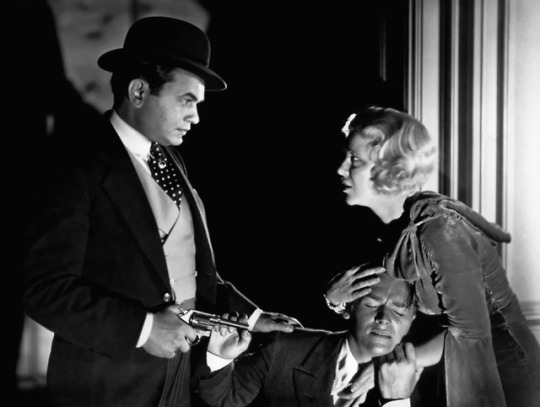
Little Caesar (1931)
For a brief window in the early 1930s, Hollywood studios churned out a small flurry of gangster films that would define the genre into the present day. Among those influential progenitors was Mervyn LeRoy’s Little Caesar, released by Warner Bros. With Little Caesar, Warner Bros. was about to assume an identity of being the “dark” studio – greenlighting socially conscious films replete with human depravity and cynicism towards authority figures or, you know, gangster films where the police are given no nobility. Little Caesar, based on W.R. Burnett’s novel of the same name and adapted by Francis Edward Faragoh, Robert Lord, and future 20th Century Fox studio head Darryl F. Zanuck, is best remembered today as the film that made Edward G. Robinson a Hollywood superstar. Robinson and Little Caesar, as a film, resembled nothing moviegoers had seen before and demand for these movies – to the horror of state and local censors and special-interest morality groups – skyrocketed.
Audiences, in the opening throes of the Depression, admired these gangsters for their craftiness in assuaging their living conditions in dire economic times while hoping for their demise. Gangster films were an expression of wrath – bottled up within Western audiences due to the obvious costs of such behavior, but fully unleashed within the confines of fiction. That wrath could be consuming for characters in these films, and was often directed at the police, politicians (at any level of government), and other crime bosses with the gall to impose their own rules on a main character. By the end of the decade, this appealing aura would be reversed by the Hays Code – a set of guidelines by the Motion Picture Association of America (MPAA) created in 1930, not fully enforced until 1934, and replaced with the MPAA ratings system in the United States in 1968 – by turning gangsters into unflattering personalities or shifting the narrative to the police attempting to capture the criminals.
Caesar Enrico “Rico” Bandello (Robinson) starts out as a minor criminal in the lower Midwest, along with friend Joe Massara (Douglas Fairbanks, Jr.). Discontent with their fortunes, they travel to Chicago – Rico joins Sam Vettori’s (Stanley Fields) gang while Joe pursues a long-held dream of being a dancer. Rico wants to help Joe rise through the gang’s hierarchy, but Joe declines when he learns the next heist is at the Bronze Peacock – the dinner-and-a-show establishment where he works. The friends go their separate ways, with Joe heeding his dance partner Olga’s (Glenda Farrell) words to leave the gangster lifestyle. At the Bronze Peacock, Rico – against the orders of “Big Boy” (Sidney Blackmer) – hails the Chicago police commissioner with a fatal gunshot. Open gang war has broken out in Chicago’s Northside, Rico believes Joe knows too much about what he has done, and friendships and fates will be determined in the film’s closing acts.
In supporting roles are William Collier, Jr.; Ralph Ince; Thomas E. Jackson as a police sergeant; Maurice Black as a rival boss; and George E. Stone as one of Rico’s henchpersons.
For modern audiences, one of the most glaring impediments to investing oneself into Little Caesar is the clunky acting from everyone who is not Edward G. Robinson (Fairbanks, Jr. feels like he is simply reading lines too often; Farrell is in her first credited feature film and will grow into her reputation as the wisecracking blonde in later comedies and musicals). The dialogue is delivered in stilted fashion, with theatrical voices being used in every scene (this is a legacy of the silent era, as actors and filmmakers were still trying to adapt themselves to synchronized sound – if Little Caesar was a silent film, I would be calling the acting anything but “clunky”). Despite this, the friendship between Rico and Joe feels like it existed even before the first minute of the film begins.
As a pre-Code film, Rico and Joe’s friendship also contains potential homoerotic subtext – Rico is completely dismissive of women as objects of sexual attraction (opens the possibility of other subtexts), he criticizes Joe’s attraction to Olga, almost always keeps his hands on his gun (concealed or otherwise) when rival men are around, the two are complete opposites but want the other to reform their ways, and Joe is the only person in the film that Rico can share his private ideas and life with. This subtext was overwhelming to ‘30s audiences, forcing W.R. Burnett (the author of the novel) to write a lambasting letter to the producers about the “conversion” of his originally and explicitly heterosexual title character. No matter Burnett’s complaints, the fact that the screenwriting team of Faragoh, Lord, and Zanuck packages this convincing friendship (or whatever it is) within a seventy-nine-minute runtime is an impressive achievement. It is also impossible without the performances of Robinson and, to a lesser extent, the junior Douglas Fairbanks.
Robinson, along with James Cagney, defined gangster films of the 1930s. Their relatively short stature – Robinson was 5′7″, Cagney 5′5″ – does not suggest a domineering physical presence on paper. But as Rico, Robinson is a fearsome menace constantly compensating for something. Rico cares little – but understands completely – about the ramifications of violence on society, friends, and families. Unlike many gangsters that would follow him, he is not seen under the influence of harder drugs or alcohol – he commits all his schemes and homicides sober. He does not have the athletic or imposing build of later gangsters, nor the cadence to force someone holding up their hands before their lights are turned off to piss their pants. Without any of this, Rico bathes himself in violence, committed to never being cuffed by the cops while still breathing (a promise to himself and the police that he exclaims several times, beaming with pleasure). His intelligence has justified killings in the name of gang loyalty and the familial structure it provides. His instincts allow him to evade capture and death from the hands of the police and rival hoodlums for a time, becoming the most feared – and, in a perverse way, admired – gangster of the Windy City.
Little Caesar does not have the scope of a gangster film directed by Francis Ford Coppola (The Godfather trilogy) or a Martin Scorsese (1990′s GoodFellas, 2006′s The Departed). Many of the clichés found in the genre have not been codified yet but appear in this film: the small-time ruffian who shoots his way to the top, the friend of said ruffian attempting to escape a life of crime before meeting an end that involves the gallows or gunfire, the girlfriend who wants their man to stop working with the gang, the intransigent crime boss too set in their ways to prevent their usurpation, the rival crime bosses who instantly recognize the upstart as a destabilizing force in the balance of gang power, the police figures gunned down to kickstart what will lead to the film’s climax. All those aspects appear in Little Caesar – omitting, for the purposes of this review and in respect for those who have not seen the film, clichés in gangster movie finales. The gangster picture, in its concentration on violent masculinity, is one of the least versatile genres innovated by Hollywood. The blame for that dearth of narrative versatility should not be assigned to films that appeared before those tropes became tropes.
With film noir the eventual successor to the early 1930s gangster films, Little Caesar does not have the chiaroscuro lighting that would define film noir. Nevertheless, some of the imagery from cinematographer Tony Gaudio (1936′s Anthony Adverse, 1938′s The Adventures of Robin Hood) breathes grittiness and even a hint of tragedy to this set-bound production when the action is not set indoors. Otherwise, Little Caesar is not imaginatively shot for long stretches. With only one chilling exception, the lack of close-ups almost prevents Robinson, as Rico, from establishing invisible bounds that his subordinates dare not cross.
Though this review, among most all others one could find on Little Caesar, has waxed about Edward G. Robinson’s violent-with-a-smile performance, Robinson himself was squeamish to the sound of gunshots. In the rushes, LeRoy and editor Ray Curtiss noticed, “Every time he squeezed the trigger, he would screw up his eyes. Take after take, he would do the same thing.” To resolve this, Robinson’s eyelids – in any scenes that involved Rico firing his guns – would be taped. Robinson, by all accounts, was anything but Caesar Enrico Bandello or any other of the gangsters he would portray on-screen. The immigrant son of a Romanian Jewish family, Emanuel Goldenberg was a fine arts lover who spoke to and of others with gentleness. He was more of a Christopher Cross from Scarlet Street (1945) or, maybe, a Martinius Jacobson from Our Vines Have Tender Grapes (1945).
Robinson would take on gangster roles – comedies and dramas – until Never a Dull Moment (1968). Somewhat typecast as the tough gangster in the coming decades, few other Robinson performances were as frightening as this. For almost that performance alone, Little Caesar is one of the most important and accomplished films of the early 1930s. It is not the first gangster film ever made, but the gangster film playbook that it wrote – alongside the other great gangster pictures shortly to follow it – has undergone few sweeping revisions since its release.
My rating: 9/10
^ Based on my personal imdb rating. My interpretation of that ratings system can be found here.
#Little Caesar#Mervyn LeRoy#Edward G. Robinson#Douglas Fairbanks Jr.#Glenda Farrell#William Collier Jr.#Sidney Blackmer#Ralph Ince#Thomas E. Jackson#Stanley Fields#Maurice Black#George E. Stone#Francis Edward Faragoh#Robert Lord#Darryl F. Zanuck#Hal B. Wallis#TCM#My Movie Odyssey
2 notes
·
View notes
Link

#frankenstein#remake#james whale#garrett fort#Francis Edward Faragoh#dwight frye#colin clive#mae clarke#boris karloff#based on#novel#mary shelley#mad scientist#mosnter#creature#drama#romance#sci-fi#sci fi#thriller#united states#edward van sloan#horror#horror film#horror films#horror movie#horror movies#horror fan#horror fans#horror review
0 notes
Text


Bela Lugosi and Dwight Frye in Dracula
Dwight Frye, Colin Clive, and Boris Karloff in Frankenstein
Dracula (Tod Browning, 1931)
Cast: Bela Lugosi, Helen Chandler, David Manners, Dwight Frye, Edward Van Sloan, Herbert Bunston, Frances Dade. Screenplay: Garrett Fort, based on a play by Hamilton Dean and John L. Balderston adapted from a novel by Bram Stoker. Cinematography: Karl Freund. Production design: John Hoffman, Herman Rosse. Film editing: Milton Carruth.
Frankenstein (James Whale, 1931)
Cast: Colin Clive, Mae Clarke, John Boles, Boris Karloff, Frederick Kerr, Dwight Frye, Edward Van Sloan, Lionel Belmore, Marilyn Harris. Screenplay: Garrett Fort, Francis Edward Faragoh, based on a story treatment by John L. Balderston of a play by Peggy Webling adapted from a novel by Mary Shelley. Cinematography: Arthur Edeson. Art direction: Charles D. Hall. Film editing: Clarence Kolster. Music: Bernhard Kaun.
Tod Browning's Dracula and James Whale's Frankenstein have a lot in common. Both were based on stage plays adapted from celebrated novels; together they established the Universal studios as specialists in horror movies, the way gangster movies seemed to characterize Warner Bros. and musicals became identified as an MGM specialty; both launched the careers of actors known almost exclusively for their roles as monsters -- a millstone around the neck of the very talented Boris Karloff, an alternate identity for the less-gifted Bela Lugosi. There are some other incidental similarities: Both feature performances by Dwight Frye, a rather ordinary looking character actor who became a specialist in creepy roles. In Dracula he's the vampire's stooge, Renfield, marked by a wheezing laugh that sounds like a cat trying to heave up a hairball. In Frankenstein he's the hunchbacked Fritz, stooge to the titular scientist. Both feature Edward Van Sloan as professorial types: the vampire expert Van Helsing and the ill-fated Dr. Waldman. Both have ingenues preyed upon by the monsters and handsome juveniles who try to be their stalwart defenders but mostly just get in the way. But Frankenstein is by far a better film than Dracula. It may be that James Whale was a more gifted director than Tod Browning, although Browning had a long career in silent films. including some standout Lon Chaney features, before Whale made his mark in Hollywood. Or it may just be that Dracula was made first, so that everyone working on Frankenstein could learn from its mistakes. Browning, I think, hadn't quite gotten used to making talkies, so that the pacing of Dracula is off: Scenes and speeches seem to halt a little longer than they need to. Dracula also betrays its origins on the stage more than Frankenstein. Apart from the spectacle of the storm at sea, there's little in Dracula that couldn't have been put on stage, whereas Frankenstein is loaded with spectacle: the opening funeral and grave-robbing scene; the sparking and flashing laboratory equipment and the thunderstorm; the murder of Little Maria; the torch-bearing villagers and the burning of the old mill. One thing they don't have much of is actual scary stuff, especially as compared to today's blood-and-gore horror movies. To contemporary audiences, Dracula and Frankenstein seem bloodless and gutless, and Dracula in particular has been deprived of its shock value by Lugosi's lack of sex appeal -- vampirism is a sexual threat, given its preoccupation with the exchange of bodily fluids, which is why vampires have gotten hotter over the years. The monster in Frankenstein on the other hand elicits sympathy: It's alone in a world it never made, which is why some think Whale, a gay man, betrays an identification with the character.
12 notes
·
View notes
Text
“BECKY SHARP” (1935) Review

"BECKY SHARP" (1935) Review
Being something of a film history buff, I have been aware of the 1935 adaptation of William Makepeace Thackeray's 1847-48 novel, "Vanity Fair" for a number of years. But I have never been inclined to watch the film, until recently.
I cannot say what led to my recent interest in "BECKY SHARP". But it was a book on David O. Selznick that made me first aware of the 1935 film. John Hay "Jock" Whitney and Cornelius Vanderbilt Whitney had founded Pioneer Pictures in 1933 as a means to produce color movies. "Jock" Whitney was close friends with Selznick. He even co-financed Selznick's production company, Selznick International, in 1935. Between the creations of Pioneer Pictures and Selznick International, the former released the first feature-length film to use the three-strip Technicolor process. "BECKY SHARP" is the sixth of eleven film and/or television adaptations of the Thackeray's novel. It is the first in color. "BECKY SHARP" took its title from the novel's main character, a poor, but educated young English lady who struggles rise in the ranks of Britain's social classes during the early years of the 19th century. Becky Sharp is the orphaned daughter of an English painter and French dancer, who graduates from Miss Pinkerton's Academy for Young Ladies with a friend named Amelia Sedley. Since Amelia is the daughter of a wealthy merchant, Becky manipulates her way into her friend's household, where she meets Amelia's portly and jovial brother, Joseph "Jos" Sedley. Before Becky can sink her hooks into Jos, the Sedley patriarch put an end to the budding "romance" by sending Jos away to India. Meanwhile, Becky finds employment as a governess at the estate of Sir Pitt Crawley. She eventually wins the heart and hand of Crawley's playboy son Rawdon, an officer in the British army. When news of Napoleon Bonaparte's escape from Elba reach Britain, Becky is reunited with Amelia, who has now married her childhood sweetheart George Osborne. The two women's husbands and William Dobbin are deployed to Belgium to face Napoleon's Army. But the last stages of the Napoleonic Wars proved to be the first of many crisis thrown Becky's way. Judging from the movie's title, it is clear to me that screenwriter Francis Edward Faragoh had deleted a great deal of Thackeray's novel in order to write a screenplay with a running time of eighty-four minutes. I found it odd that a film adaptation of such a famous epic novel would have such a short running time. Other epics and movie adaptations of literary works had running times that sometimes went past two hours - including "A TALE OF TWO CITIES", "MUTINY ON THE BOUNTY", "THE CRUSADES", and "CAPTAIN BLOOD". I can only assume that a minor and newly formed production company like Pioneer Pictures could not afford to produce the first Technicolor feature film with a running time close to or over two hours. If that was the case . . . if the Whitneys were that determined to produce the first full-featured movie in color . . . they could have chosen something that was not an adaptation of a famous epic novel. I find it ironic that Mina Nair's 2004 adaptation of Thackeray's novel had received a great deal of criticism for not being truly faithful to its source. I have encountered less criticism of "BECKY SHARP" than I did for the 2004 film. Yet, the latter is more faithful than the former. One of my problems with "BECKY SHARP" is that I thought the producers, director Rouben Mamoulian and screenwriter Francis Edward Faragoh did a piss poor job of adapting Thackery's novel to the screen. I just learned that the 1935 movie is actually an adaptation of Langdon Elwyn Mitchell's 1899 play, which was an adaptation of the 1847-48 novel. I hate to say this, but the movie's running time of eighty-four (84) minutes did not serve the story. There is so much in "BECKY SHARP" that was left out. Most of the narrative that focused upon Amelia was deleted, especially her fractious relationship with her father-in-law, Mr. Osborne. In fact, George's father never made an appearance in this film. I suspect the same could be said about Mitchell's play. The only time the movie focused upon Amelia's character arc was when Becky was personally involved . . . namely George's infatuation with Becky before the Waterloo battle and Becky forcing Amelia to face the truth about George in the movie's last fifteen to twenty minutes. It is not surprising that the movie's title was based upon the main character's name. Not only was much of Amelia's personal story deleted, the movie also rushed through Becky's stay with the Sedley and Crawley families. It seemed as if Mamoulian and Faragoh could not wait to focus on the impact of Waterloo and the marriage between Becky and Rawdon. Between the handling of Amelia's character arc and the rushed narrative in the movie's first half, it is no wonder that I found "BECKY SHARP" particularly unsatisfying. I found other aspects of "BECKY SHARP" unsatisfying. The sound and visual quality of the movie's DVD version low in quality. The photography and color struck me as faded. And the sound is scratchy. For once, I am not blaming the movie's filmmakers. Whoever had possession of "BECKY SHARP" after Pioneer Pictures had failed to maintain its original quality. But I can blame the filmmakers on other aspects of the movie. In it, the Jos Sedley character returned to Europe with a little Indian boy in tow as his personal servant. Only the "Indian servant" was portrayed by a young African-American actor named Jimmy Robinson. To this day, I am still trying to figure out how the producers and director Rouben Mamoulian saw nothing wrong in an African-American kid portraying an Indian kid. Hollywood's casting for non-white characters seemed really skewed in this film. And then . . . there was the acting. I am surprised that "BECKY SHARP" led to a Best Actress Oscar nomination for actress Miriam Hopkins. Granted, she handled the character's questionable morality, desperation and charm very well. Yet, Hopkins engaged in so much hammy acting that I found myself wondering why of all her performances, she ended up earning a nomination for this particular one. I wish I could say that the rest of the cast gave better performances . . . but I cannot. Other cast members gave equally hammy performances. Nigel Bruce, Alan Mowbray, Alison Skipworth, G.P. Huntley and many others were equally hammy. I could not accuse Colin Tapley of hamminess on the same scale. But I found his portrayal of William Dobbin rather dramatic. And I am not being complimentary. The only cast members who actually impressed me were Frances Dee and Cedric Hardwicke. Dee gave a surprisingly subtle and convincing performance as the sweet and passive Amelia Sedley. Thanks to Dee's performances, audiences saw both the positive and negative aspects of Amelia's passiveness. Hardwicke was equally subtle as Becky's aristocratic "benefactor", the Marquis of Steyne. Even though Steyne is an unlikable character, Hardwicke was no mustache-twirling villain. The only reason I would recommend "BECKY SHARP" to anyone is for historical purposes. Because this is the first feature-length motion picture in color, I would recommend this movie to any film buff. Otherwise, I would stay clear of "BECKY SHARP" and consider other adaptations of William Makepeace Thackery's novel.

#becky sharp#becky sharp 1935#vanity fair novel#William Makepeace Thackeray#rouben mamoulian#pioneer pictures#miriam hopkins#frances dee#alan mowbray#cedric hardwicke#nigel bruce#battle of waterloo#g.p. huntley jr.#alison skipworth#william stack#george hassell#billie burke#jimmy robinson#charles richman#doris lloyd#hollywood history#Golden Age of Hollywood#old hollywood#jock whitney#period drama#period dramas#costume dramas#regency era#vanity fair
5 notes
·
View notes
Photo

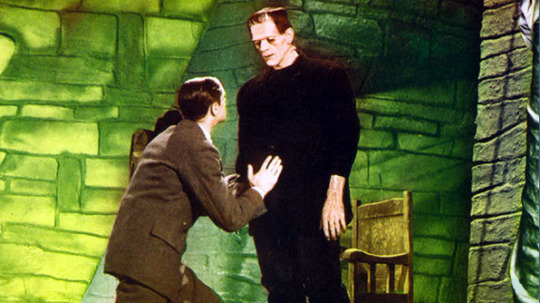
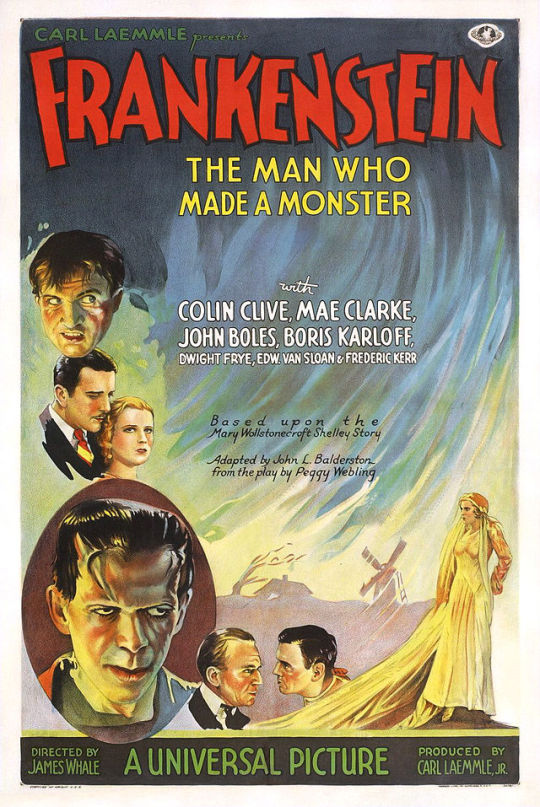




Frankenstein (1931 film)
Frankenstein is a 1931 American pre-Code science fiction horror film directed by James Whale, produced by Carl Laemmle Jr., and adapted from a 1927 play by Peggy Webling, which in turn was based on Mary Shelley's 1818 novel Frankenstein; or, The Modern Prometheus. The Webling play was adapted by John L. Balderston and the screenplay written by Francis Edward Faragoh and Garrett Fort, with uncredited contributions from Robert Florey and John Russell.
Frankenstein stars Colin Clive as Henry Frankenstein, an obsessed scientist who digs up corpses with his assistant in order to assemble a living being from body parts. The resulting creature, often known as Frankenstein's monster, is portrayed by Boris Karloff. The make-up for the monster was provided by Jack Pierce. Alongside Clive and Karloff, the film's cast also includes Mae Clarke, John Boles, Dwight Frye, and Edward Van Sloan.
Produced and distributed by Universal Pictures, the film was a commercial success upon release, and was generally well received by both critics and audiences. It spawned a number of sequels and spin-offs, and has had a significant impact on popular culture: the imagery of a maniacal "mad" scientist with a subservient hunchbacked assistant and the film's depiction of Frankenstein's monster have since become iconic. In 1991, the United States Library of Congress selected Frankenstein for preservation in the National Film Registry as being "culturally, historically, or aesthetically significant".[4][5]
0 notes
Text
Tuesday, November 10, 1931|Honoring movies released from August 1, 1930 - July 31, 1931
OUTSTANDING PRODUCTION
youtube
WINNER
CIMARRON
RKO Radio
NOMINEES
EAST LYNNE
Fox
THE FRONT PAGE
The Caddo Company
SKIPPY
Paramount Publix
TRADER HORN
Metro-Goldwyn-Mayer
DIRECTING
youtube
WINNER
SKIPPY
Norman Taurog
NOMINEES
CIMARRON
Wesley Ruggles
A FREE SOUL
Clarence Brown
THE FRONT PAGE
Lewis Milestone
MOROCCO
Josef Von Sternberg
CINEMATOGRAPHY
youtube
WINNER
TABU
Floyd Crosby
NOMINEES
CIMARRON
Edward Cronjager
MOROCCO
Lee Garmes
THE RIGHT TO LOVE
Charles Lang
SVENGALI
Barney "Chick" McGill
ACTOR

WINNER
LIONEL BARRYMORE
A Free Soul
NOMINEES
JACKIE COOPER
Skippy
RICHARD DIX
Cimarron
FREDRIC MARCH
The Royal Family of Broadway
ADOLPHE MENJOU
The Front Page
ACTRESS

WINNER
MARIE DRESSLER
Min and Bill
NOMINEES
MARLENE DIETRICH
Morocco
IRENE DUNNE
Cimarron
ANN HARDING
Holiday
NORMA SHEARER
A Free Soul
ART DIRECTION
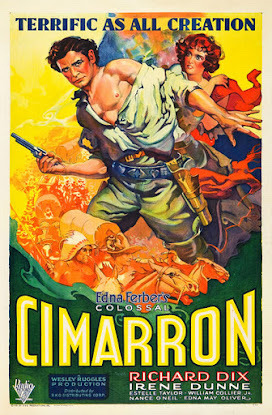
WINNER
CIMARRON
Cimarron
NOMINEES
JUST IMAGINE
Stephen Goosson, Ralph Hammeras
MOROCCO
Hans Dreier
SVENGALI
Anton Grot
WHOOPEE!
Richard Day
WRITING (ORIGINAL STORY)

WINNER
THE DAWN PATROL
John Monk Saunders
NOMINEES
THE DOORWAY TO HELL
Rowland Brown
LAUGHTER
Harry d'Abbadie d'Arrast, Douglas Doty, Donald Ogden Stewart
THE PUBLIC ENEMY
John Bright, Kubec Glasmon
SMART MONEY
Lucien Hubbard, Joseph Jackson
WRITING (ADAPTATION)

WINNER
CIMARRON
Howard Estabrook
NOMINEES
THE CRIMINAL CODE
Seton I. Miller, Fred Niblo, Jr.
HOLIDAY
Horace Jackson
LITTLE CAESAR
Francis Faragoh, Robert N. Lee
SKIPPY
Joseph L. Mankiewicz, Sam Mintz
0 notes
Photo

Kicking off the Halloween Season with a classic!!! 📺🎞 #LateNightCinema 🎃 #CountdownToHalloween Watching “Frankenstein”, a 1931 American pre-Code science fiction horror film directed by James Whale, produced by Carl Laemmle Jr., and adapted from a 1927 play by Peggy Webling, which in turn was based on Mary Shelley's 1818 novel Frankenstein; or, The Modern Prometheus. The Webling play was adapted by John L. Balderston and the screenplay written by Francis Edward Faragoh and Garrett Fort, with uncredited contributions from Robert Florey and John Russell. Produced and distributed by Universal Pictures, the film was a commercial success upon release, and was generally well received by both critics and audiences. It spawned a number of sequels and spin-offs, and has had a significant impact on popular culture, with the imagery of a scientist's hunchbacked assistant—as well as the film's depiction of Frankenstein's monster—becoming iconic. In 1991, the United States Library of Congress selected Frankenstein for preservation in the National Film Registry as being "culturally, historically, or aesthetically significant." Plot: This iconic horror film follows the obsessed scientist Dr. Henry Frankenstein (Colin Clive) as he attempts to create life by assembling a creature from body parts of the deceased. Aided by his loyal misshapen assistant, Fritz (Dwight Frye), Frankenstein succeeds in animating his monster (Boris Karloff), but, confused and traumatized, it escapes into the countryside and begins to wreak havoc. Frankenstein searches for the elusive being, and eventually must confront his tormented creation. #film #movie #horror #universalhorror #boriskarloff #frankenstein #halloweennight #cinemaclassic #jameswhale (at Los Angeles, California) https://www.instagram.com/p/CGg-NUhn0KO/?igshid=l2y2wiackos2
#latenightcinema#countdowntohalloween#film#movie#horror#universalhorror#boriskarloff#frankenstein#halloweennight#cinemaclassic#jameswhale
0 notes
Photo

Dracula, Frankenstein, The Invisible Man, and The Wolf Man will be released on 4K Ultra HD (with Blu-ray and Digital) together in the Universal Classic Monsters: Icons of Horror Collection on October 5 via Universal.
1931's Dracula is directed by Tod Browning (Freaks) and written by Garrett Fort (Frankenstein), based on Bram Stoker's 1897 novel. Bela Lugosi, David Manners, Helen Chandler, Dwight Frye, and Edward Van Sloan star.
1931's Frankenstein is directed by James Whale (The Indivisible Man) and written by Garrett Fort (Dracula) and Francis Edward Faragoh (Little Caesar), based on Mary Shelley's 1818 novel. Colin Clive, Mae Clarke, John Boles, and Boris Karloff star.
1933's The Invisible Man is directe by James Whale (Frankenstein) and written by R.C. Sherriff (Goodbye, Mr. Chips), based on H.G. Wells' 1897 novel. Gloria Stuart, Claude Rains, William Harrigan, Dudley Digges, and Una O'Connor star.
1941's The Wolf Man is directed by George Waggner (Operation Pacific) and written by Curt Siodmak (I Walked with a Zombie). Claude Rains, Warren William, Ralph Bellamy, Patric Knowles, Bela Lugosi, and Lon Chaney Jr. star.
The eight-disc set comes in Digibook packaging. The Spanish version of Dracula is also included. Special features are previewed below.

Special features:
Dracula - 1931 Spanish version directed by George Melford using the same sets as Tod Browning's production
The Road to Dracula
The Frankenstein Files: How Hollywood Made a Monster
Karloff: The Gentle Monster
Monster by Moonlight
The Wolf Man: From Ancient Curse to Modern Myth
Now Your See Him: The Invisible Man Revealed
Feature commentaries
And more!
From the era of silent movies through present day, Universal Pictures has been regarded as the home of the monsters. Universal Classic Monsters Icons of Horror Collection showcases four of the most iconic monsters in motion picture history including Dracula, Frankenstein, The Invisible Man and The Wolf Man. Starring Bela Lugosi, Boris Karloff, Lon Chaney Jr. and Claude Rains in the roles that they made famous, these original films set the standard for a new horror genre with revolutionary makeup, mood-altering cinematography and groundbreaking special effects.
Pre-order Universal Classic Monsters: Icons of Horror Collection from Amazon.
#dracula#frankenstein#the invisible man#the wolf man#universal monsters#dvd#gift#horror#wolf man#invisible man#bela lugosi#boris karloff#claude rains#lon chaney#lon chaney jr.
49 notes
·
View notes
Link
For just $3.99 Dancing Pirate Released on May 22, 1936: A dancing teacher from Boston is kidnapped and put aboard a pirate ship. Directed by: Lloyd Corrigan Written by: Emma-Lindsay Squier with screenplay by Ray Harris, Francis Edward Faragoh, Jack Wagner andBoris Ingster. The Actors: Charles Collins Jonathan Pride, Frank Morgan Mayor Don Emilio Perena, Steffi Duna Serafina Perena, Luis Alberni Pamfilo the jailer, Victor Varconi Don Balthazar, Monterey Captain of the Guard, Jack La Rue Lieutenant Chago, Baltazar's aide, Alma Real Blanca, Serafina's maid, William V. Mong Tecolote, the old Indian, Mitchell Lewis Pirate Chief, Julian Rivero shepherd, John Eberts Mozo, The Royal Cansino Dancers dancers, Eduardo Cansino specialty dancer, Rita Hayworth specialty dancer, Nora Cecil landlady, Jim Farley sailor, Cy Kendall Bouncing Betty's cook, Vera Lewis Orville's mother, Ellen Lowe Miss Ponsonby, Pat Nixon dance class student, Marjorie Reynolds dancer, Max Wagner pirate, Harold Waldridge Orville. Runtime: 1h 23m *** This item will be supplied on a quality disc and will be sent in a sleeve that is designed for posting CD's DVDs *** This item will be sent by 1st class post for quick delivery. Should you not receive your item within 12 working days of making payment, please contact us as it is unusual for any item to take this long to be delivered. Note: All my products are either my own work, licensed to me directly or supplied to me under a GPL/GNU License. No Trademarks, copyrights or rules have been violated by this item. This product complies withs rules on compilations, international media and downloadable media. All items are supplied on CD or DVD.
0 notes
Text
Frankenstein (1931) – Episode 100 – Decades of Horror: The Classic Era
"Crazy, am I? We'll see whether I'm crazy or not." To rephrase the question, “Crazy, are we?” The Grue-Crew answers, “Yes! 100 episodes worth of crazy for classic horror!” Join this episode’s Grue-Crew - Whitney Collazo, Chad Hunt, Daphne Monary-Ernsdorff, Joseph Perry, and Jeff Mohr along with guest host Michael Steinberg - as they celebrate episode 100 with the granddaddy of them all, James Whale’s Frankenstein (1931).
Decades of Horror: The Classic Era Episode 100 – Frankenstein (1931)
Join the Crew on the Gruesome Magazine YouTube channel! Subscribe today! And click the alert to get notified of new content! https://youtube.com/gruesomemagazine
ANNOUNCEMENT Decades of Horror The Classic Era is partnering with THE CLASSIC SCI-FI MOVIE CHANNEL which will now include video episodes of The Classic Era! Available on Roku, AppleTV, Amazon FireTV, AndroidTV, Online Website. Across All OTT platforms, as well as mobile, tablet, and desktop. https://classicscifichannel.com/
Dr. Frankenstein dares to tamper with life and death by creating a human monster out of lifeless body parts.
IMDb
Director: James Whale
Writers:
John L. Balderston (based upon the composition by),
Mary Shelley (from Frankenstein; or, The Modern Prometheus, 1818, by) (as Mrs. Percy B. Shelley)
Peggy Webling (adapted from the play by)
Garrett Fort (screen play) &
Francis Edward Faragoh (screen play) (as Francis Edwards Faragoh)
Richard Schayer (scenario editor)
Robert Florey (contributor to treatment) (uncredited)
John Russell (contributor to screenplay construction) (uncredited)
Art Direction: Charles D. Hall
Cinematography: Arthur Edeson
Makeup Department
Pauline Eells, wig maker (uncredited)
Jack P. Pierce, makeup artist (uncredited) / makeup designer (uncredited)
Cast
Colin Clive as Henry Frankenstein
Mae Clarke as Elizabeth Lavenza
John Boles as Victor Moritz
Boris Karloff as The Monster
Edward Van Sloan as Dr. Waldman
Frederick Kerr as Baron Frankenstein
Dwight Frye as Fritz
Lionel Belmore as Herr Vogel, the Burgomaster
Marilyn Harris as Little Maria
Michael Mark as Ludwig, Maria's father
Michael, our guest host from the Classic Sci-Fi Movie Channel, PlayNow Media, and Found Footage Critic, admits he probably saw Frankenstein when he was far too young. Even the “?” in the opening credit for the monster gave him chills. Daphne credits Frankenstein with getting her into the details of costumes and even patterned her wedding dress as closely as possible after the wedding dress in the film. Guillermo del Toro’s quote on the “fragility and power” of Karloff’s performance resonates with Whitney and she is impressed with how the makeup is at once beautiful and creepy. Edward Van Sloan’s introduction to Frankenstein got Chad wound up as a child and he has come to consider James Whale as a visionary director, ahead of his time. There are so many aspects of Frankenstein that have affected us all, according to Joseph, but this time around, he focuses on the iconic laboratory set design and the wide range of emotions elicited by the film and its characters. Jeff can’t remember his first encounter with Frankenstein, claiming it seems as if we were born with an intrinsic knowledge of the Universal monsters, which Joseph then refers to as “schoolyard legends.”
You know you need to see Frankenstein again and again and again. It’s available in a variety of collections on Blu-ray and on a variety of streaming subscription services or as VOD.
Gruesome Magazine’s Decades of Horror: The Classic Era records a new episode every two weeks. In the next episode, their 101st episode, they will discuss a movie chosen by Joseph, Toho’s Rodan (1956). Be sure to be there as the Classic Era Grue-Crew embarks on their second 100 episodes!
Please let them know how they’re doing! They want to hear from you – the coolest, grooviest fans: leave them a message or leave a comment on the site or email the Decades of Horror: The Classic Era podcast hosts at [email protected]
To each of you from each of us, “Thank you so much for listening!”
Check out this episode!
0 notes